Easter Rising - Picture
More about World War 1
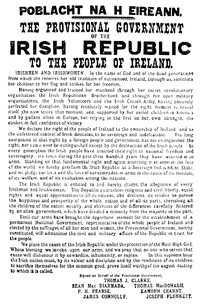
|
|
Easter Rising

Date: Date
24-30 April 1916
Location
Dublin,
skirmishes in counties Meath, Galway, Louth, and Wexford
Result
Unconditional surrender of rebel forces, execution of leaders
Date: 24-30 April 1916
Location: Dublin,
skirmishes in counties Meath, Galway, Louth, and Wexford
Result: Unconditional surrender of rebel forces, execution of leaders
Belligerents:
: Irish Republican Brotherhood
Irish Volunteers
Irish Citizen Army
Cumann na mBan
Hibernian Rifles
Fianna xireann
Commanders and leaders:
: Patrick Pearse
James Connolly
Strength:
: 1,250 in Dublin,
~2,000-3,000 elsewhere, but they took little part in the fighting.
Casualties and losses:
: 64 killed
unknown wounded
16 executed
: 254 civilians killed
2,217 civilians wounded
Events
Home Rule Crisis (1912-14)
Easter Rising (1916)
Conscription Crisis (1918)
Irish general election (1918)
Declaration of Independence (1919)
War of Independence (1919-22)
Creation of Northern Ireland (1921)
Anglo-Irish Treaty (1921)
Civil War (1922-23)
Organisations
Irish Republican Brotherhood - Irish Parliamentary Party - Sinn Féin - Irish Volunteers - Irish Republican Army - Irish Citizen Army - Ulster Unionist Party - Ulster Volunteers
The Easter Rising (Irish: xirx Amach na Cx¡sca) was an insurrection staged in Ireland during Easter Week, 1916. The Rising was mounted by Irish republicans with the aims of ending British rule in Ireland and establishing the Irish Republic. It was the most significant uprising in Ireland since the rebellion of 1798.
Organised by the Military Council of the Irish Republican Brotherhood, the Rising lasted from Easter Monday 24 April to 30 April 1916. Members of the Irish Volunteers, led by schoolteacher and barrister Patrick Pearse, joined by the smaller Irish Citizen Army of James Connolly, along with 200 members of Cumann na mBan, seized key locations in Dublin and proclaimed the Irish Republic independent of Britain. There were some actions in other parts of Ireland but, except for the attack on the Royal Irish Constabulary barracks at Ashbourne, County Meath, they were minor.
The Rising was suppressed after seven days of fighting, and its leaders were court-martialled and executed, but it succeeded in bringing physical force republicanism back to the forefront of Irish politics. In the 1918 General Election to the British Parliament, republicans (then represented by the Sinn Féin party) won 73 seats out of 105 on a policy of abstentionism and Irish independence. This came less than two years after the Rising. In January 1919, the elected members of Sinn Féin who were not still in prison at the time, including survivors of the Rising, convened the First Dx¡il and established the Irish Republic. The British government refused to accept the legitimacy of the newly declared nation, precipitating the Irish War of Independence.
Background
The Act of Union 1801 united the Kingdom of Great Britain and the Kingdom of Ireland, abolishing the Irish Parliament and giving Ireland representation at Westminster. From early on, many Irish nationalists opposed the union and what was seen as the exploitation of the country.
Opposition took various forms: constitutional (the Repeal Association; the Home Rule League), social (disestablishment of the Church of Ireland; the Land League) and revolutionary (Rebellion of 1848; Fenian Rising). Constitutional nationalism enjoyed its greatest success in the 1880s and 1890s when the Irish Parliamentary Party under Charles Stewart Parnell succeeded in having two Home Rule bills introduced by the Liberal government of William Ewart Gladstone, though both failed. The First Home Rule Bill of 1886 was defeated in the House of Commons, while the Second Home Rule Bill of 1893 was passed by the Commons but rejected by the House of Lords. After the fall of Parnell, younger and more radical nationalists became disillusioned with parliamentary politics and turned towards more extreme forms of separatism. The Gaelic Athletic Association, the Gaelic League and the cultural revival under W. B. Yeats and Lady Augusta Gregory, together with the new political thinking of Arthur Griffith expressed in his newspaper Sinn Féin and the organisations the National Council and the Sinn Féin League led to the identification of Irish people with the concept of a Gaelic nation and culture, completely independent of Britain. This was sometimes referred to by the generic term Sinn Féin.
The Third Home Rule Bill was introduced by British Prime Minister H. H. Asquith in 1912. The Irish Unionists, led by Sir Edward Carson, opposed home rule in the light of what they saw as an impending Roman Catholic-dominated Dublin government. They formed the Ulster Volunteer Force on 13 January 1913.
The Irish Republican Brotherhood (IRB) saw an opportunity to create an armed organisation to advance its own ends, and on 25 November 1913 the Irish Volunteers, whose stated object was "to secure and to maintain the rights and liberties common to all the people of Ireland", was formed. Its leader was Eoin MacNeill, who was not an IRB member. A Provisional Committee was formed that included people with a wide range of political views, and the Volunteers' ranks were open to "all able-bodied Irishmen without distinction of creed, politics or social group." Another militant group, the Irish Citizen Army, was formed by trade unionists as a result of the Dublin Lockout of that year. However, the increasing militarisation of Irish politics was overshadowed soon after by the outbreak of a larger conflict-the First World War and Ireland's involvement in the conflict.
Planning the Rising
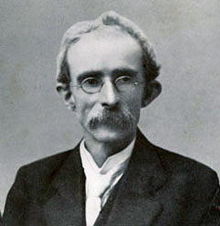
Picture - Tom Clarke
The Supreme Council of the IRB met on 5 September 1914, a month after the United Kingdom declared war on Germany. At this meeting they decided to stage a rising before the war ended and to accept whatever help Germany might offer. Responsibility for the planning of the rising was given to Tom Clarke and Sex¡n MacDermott. The Irish Volunteers, the smaller of the two forces resulting from the September 1914 split over support for the British war effort, set up a "headquarters staff" that included Patrick Pearse as Director of Military Organisation, Joseph Plunkett as Director of Military Operations and Thomas MacDonagh as Director of Training. xamonn Ceannt was later added as Director of Communications. In May 1915 Clarke and MacDermott established a Military Committee within the IRB, consisting of Pearse, Plunkett and Ceannt, to draw up plans for a rising. This dual rx´le allowed the Committee, to which Clarke and MacDermott added themselves shortly afterwards, to promote their own policies and personnel independently of both the Volunteer Executive and the IRB Executive-in particular Volunteer Chief of Staff Eoin MacNeill, who was opposed to a rising unless popular support was secured by the introduction of conscription or an attempt to suppress the Volunteers or its leaders, and IRB President Denis McCullough, who held similar views. IRB members held officer rank in the Volunteers throughout the country and would take their orders from the Military Committee, not from MacNeill.
Picture - Sex¡n MacDermott
Plunkett had travelled to Germany in April 1915 to join Roger Casement. Casement had gone there from the United States the previous year with the support of Clan na Gael leader John Devoy, and after discussions with the German Ambassador in Washington, Count von Bernstorff, to try to recruit an "Irish Brigade" from among Irish prisoners of war and secure German support for Irish independence. Together Plunkett and Casement presented a plan which involved a German expeditionary force landing on the west coast of Ireland, while a rising in Dublin diverted the British forces so that the Germans, with the help of local Volunteers, could secure the line of the River Shannon.
James Connolly, head of the Irish Citizen Army (ICA), a group of armed socialist trade union men and women, was unaware of the IRB's plans, and threatened to start a rebellion on his own if other parties failed to act. If they had gone it alone, the IRB and the Volunteers would possibly have come to their aid, however the IRB leaders met with Connolly in January 1916 and convinced him to join forces with them. They agreed to act together the following Easter and made Connolly the sixth member of the Military Committee. Thomas MacDonagh would later become the seventh and final member.
Build-up to Easter Week
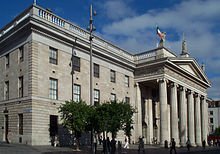
Picture - General Post Office, Dublin. Centre of the Easter Rising
In an effort to thwart informers and, indeed, the Volunteers' own leadership, Pearse issued orders in early April for three days of "parades and manoeuvres" by the Volunteers for Easter Sunday (which he had the authority to do, as Director of Organization). The idea was that the republicans within the organization (particularly IRB members) would know exactly what this meant, while men such as MacNeill and the British authorities in Dublin Castle would take it at face value. However, MacNeill got wind of what was afoot and threatened to "do everything possible short of phoning Dublin Castle" to prevent the rising.
MacNeill was briefly convinced to go along with some sort of action when Mac Diarmada revealed to him that a shipment of German arms was about to land in County Kerry, planned by the IRB in conjunction with Roger Casement; he was certain that the authorities' discovery of such a shipment would inevitably lead to suppression of the Volunteers, thus the Volunteers were justified in taking defensive action (including the originally planned maneuvers). Casement, disappointed with the level of support offered by the Germans, returned to Ireland on a German U-boat and was captured upon landing at Banna Strand in Tralee Bay. The arms shipment, aboard the German ship Aud - disguised as a Norwegian fishing trawler-had been scuttled after interception by the Royal Navy, after the local Volunteers had failed to rendezvous with it.
The following day, MacNeill reverted to his original position when he found out that the ship carrying the arms had been scuttled. With the support of other leaders of like mind, notably Bulmer Hobson and The O'Rahilly, he issued a countermand to all Volunteers, canceling all actions for Sunday. This only succeeded in putting the rising off for a day, although it greatly reduced the number of Volunteers who turned out.
British Naval Intelligence had been aware of the arms shipment, Casement's return and the Easter date for the rising through radio messages between Germany and its embassy in the United States that were intercepted by the Navy and deciphered in Room 40 of the Admiralty. The information was passed to the Under-Secretary for Ireland, Sir Matthew Nathan, on 17 April, but without revealing its source, and Nathan was doubtful about its accuracy. When news reached Dublin of the capture of the Aud and the arrest of Casement, Nathan conferred with the Lord Lieutenant, Lord Wimborne. Nathan proposed to raid Liberty Hall, headquarters of the Citizen Army, and Volunteer properties at Father Matthew Park and at Kimmage, but Wimborne was insisting on wholesale arrests of the leaders. It was decided to postpone action until after Easter Monday and in the meantime Nathan telegraphed the Chief Secretary, Augustine Birrell, in London seeking his approval. By the time Birrell cabled his reply authorising the action, at noon on Monday 24 April 1916, the Rising had already begun.
The Rising Itself
Easter Monday
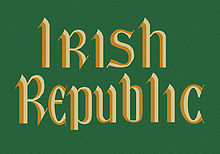
Picture - One of two flags flown over the GPO during the Rising
Early on Monday morning, April 24, 1916, roughly 1,200 Volunteers and Citizen Army members took over strongpoints in Dublin city centre. A joint force of about 400 Volunteers and Citizen Army gathered at Liberty Hall under the command of Commandant James Connolly.
The rebel headquarters was located at the General Post Office (GPO) where James Connolly, overall military commander and four other members of the Military Council: Patrick Pearse, Tom Clarke, Sex¡n Mac Dermott and Joseph Plunkett were located. After occupying the Post Office, the Volunteers hoisted two republican flags and Pearse read a Proclamation of the Republic
Elsewhere, rebel forces took up positions at the Four Courts, the centre of the Irish legal establishment, at Jacob's Biscuit Factory and Boland's Mill and at the hospital complex at South Dublin Union and the adjoining Distillery at Marrowbone Lane. Another contingent, under Michal Mallin, dug in on St. Stephen's Green.
However, although it was lightly guarded, Volunteer and Citizen Army forces under Sex¡n Connolly failed to take Dublin Castle, the centre of British rule in Ireland, shooting dead a police sentry and overpowering the soldiers in the guardroom, but failing to press home the attack. The Under-secretary, Sir Matthew Nathan, was alerted by the shots and helped close the castle gates. The rebels occupied the Dublin City Hall and adjacent buildings. They also failed to take Trinity College, which was located in the heart of the city centre and which was defended by only a handful of armed, unionist students. At midday a small team of Volunteers and Fianna members attacked the Magazine Fort in the Phoenix Park and disarmed the guards, with the intent to seize weapons and blow up the building as a signal that the rising had begun. They set explosives but failed to obtain any arms. .
In at least two incidents, at Jacobs and Stephens Green, the Volunteers and Citizen Army shot dead civilians who were trying to attack them or dismantle their barricades. Elsewhere, they hit civilians with their rifle butts to drive them off.
The British military were caught totally unprepared by the rebellion and their response of the first day was generally un-coordinated. Two troops of British cavalry, one at the Four Courts, the other on O'Connell Street, sent out to investigate what was happening, took fire and casualites from rebel forces On Mount Street, a group of reserve volunteer soldiers, stumbled upon the rebel position and four were killed before they reached Beggars Bush barracks.
The only substantial combat of the first day of the Rising took place at the South Dublin Union where a piquet from the Royal Irish Regiment, encountered an outpost of xamonn Ceannt's force at the north-western corner of the South Dublin Union. The British troops, after taking some casualties, managed to regroup and launch several assaults on the position before they forced their way inside and the small rebel force in the tin huts at the eastern end of the Union surrendered. However, the Union complex as a whole remained in rebel hands.
Three of the unarmed Dublin Metropolitan Police were shot dead on the first day of the Rising and their Commissioner pulled them off the streets. Partly as result of the withdrawal of the police, a wave of looting broke out in the city centre, especially in the O'Connell Street area. A total of 425 people were arrested after the Rising for looting.
Tuesday to Saturday
![World War 1 Picture - A British armoured truck, hastily built from the smokeboxes of several steam locomotives at Inchicore railway works[44]](./images/1-images52211/220px-Ire-1916-Dublin.jpg)
Picture - A British armoured truck, hastily built from the smokeboxes of several steam locomotives at Inchicore railway works[44]
Lord Wimborne, the Lord Lieutenant, declared martial law on Tuesday evening and handed over civil power to Brigadier-General W. H. M. Lowe. British forces initially put their efforts into securing the approaches to Dublin Castle and isolating the rebel headquarters, which they believed was in Liberty Hall. The British commander, Lowe, worked slowly, unsure of the size of the force he was up against, and with only 1,269 troops in the city when he arrived from the Curragh Camp in the early hours of Tuesday 25 April. City Hall was taken from the rebel unit that had attacked Dublin Castle on Tuesday morning.
The rebels had failed to take either of Dublin's two main train stations or either of its ports, at Dublin Port and Kingstown. As a result, during the following week, the British were able to bring in thousands of reinforcements from England and from their garrisons at the Curragh and Belfast. By the end of the week, British strength stood at over 16,000 men. Their firepower was provided by field artillery summoned from their garrison at Athlone which they positioned on the northside of the city at Phibsborough and at Trinity College, and by the patrol vessel Helga, which sailed up the Liffey, having been summoned from the port at Kingstown. On Wednesday, 26 April, the guns at Trinity College and Helga shelled Liberty Hall, and the Trinity College guns then began firing at rebel positions, first at Boland's Mill and then in O'Connell Street.
Combat
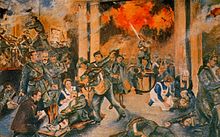
Picture - "Birth of the Irish Republic" by Walter Paget, depicting the GPO during the shelling
The principal rebel positions at the GPO, the Four Courts, Jacob's Factory and Boland's Mill saw little combat. The British surrounded and bombarded them rather than assault them directly. One Volunteer in the GPO recalled, "we did practically no shooting as there was no target". Similarly the rebel position at St Stephen's Green, held by the Citizen Army under Michael Mallin, was made untenable after the British placed snipers and machine guns in the Shelbourne Hotel and surrounding buildings. As a result, Mallin's men retreated to the Royal College of Surgeons building where they remained for the rest of the week. However, where the insurgents dominated the routes by which the British tried to funnel reinforcements into the city, there was fierce fighting.
Reinforcements were sent to Dublin from England, and disembarked at Kingstown on the morning of 26 April. Heavy fighting occurred at the rebel-held positions around the Grand Canal as these troops advanced towards Dublin. The Sherwood Foresters were repeatedly caught in a cross-fire trying to cross the canal at Mount Street. Seventeen Volunteers were able to severely disrupt the British advance, killing or wounding 240 men. Despite there being alternative routes across the canal nearby, General Lowe ordered repeated frontal assaults on the Mount Street position. The British eventually took the position, which had not been reinforced by the nearby rebel garrison at Boland's Mills, on Thursday but the fighting there inflicted up to two thirds of their casualties for the entire week for a cost of just four dead Volunteers.
The rebel position at the South Dublin Union (site of the present day St. James's Hospital) and Marrowbone Lane, further west along the canal, also inflicted heavy losses on British troops. The South Dublin Union was a large complex of buildings and there was vicious fighting around and inside the buildings. Cathal Brugha, a rebel officer, distinguished himself in this action and was badly wounded. By the end of the week the British had taken some of the buildings in the Union, but others remained in rebel hands. British troops also took casualties in unsuccessful frontal assaults on the Marrowbone Lane Distillery.
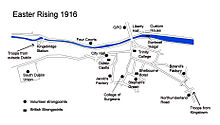
Picture - Placements of Rebel forces and British troops around the River Liffey in Dublin
The third major scene of combat during the week was at North King Street, behind the Four Courts, where the British, on Thursday, tried to take a well-barricaded rebel position. By the time of the rebel headquarter's surrender, the South Staffordshire Regiment under Colonel Taylor had advanced only 150 yards down the street at a cost of 11 dead and 28 wounded. The enraged troops broke into the houses along the street and shot or bayonetted 15 male civilians whom they accused of being rebel fighters.
Elsewhere, at Portobello Barracks, an officer named Bowen Colthurst summarily executed six civilians, including the pacifist nationalist activist, Francis Sheehy-Skeffington. These instances of British troops killing Irish civilians would later be highly controversial in Ireland.
Surrender
The headquarters garrison at the GPO, after days of shelling, was forced to abandon their headquarters when fire caused by the shells spread to the GPO. Connolly had been incapacitated by a bullet wound to the ankle and has passed command on to Pearse. The O'Rahilly was killed in a sortie from the GPO. They tunnelled through the walls of the neighbouring buildings in order to evacuate the Post Office without coming under fire and took up a new position in 16 Moore Street. On Saturday 29 April, from this new headquarters, after realizing that they could not break out of this position without further loss of civilian life, Pearse issued an order for all companies to surrender. Pearse surrendered unconditionally to Brigadier-General Lowe. The surrender document read:
"In order to prevent the further slaughter of Dublin citizens, and in the hope of saving the lives of our followers now surrounded and hopelessly outnumbered, the members of the Provisional Government present at headquarters have agreed to an unconditional surrender, and the commandants of the various districts in the City and County will order their commands to lay down arms."
The GPO was the only major rebel post to be physically taken during the week. The others surrendered only after Pearse's surrender order, carried by nurse named Elizabeth O'Farrell, reached them. Sporadic fighting therefore continued until Sunday, when word of the surrender was got to the other rebel garrisons. Command of British forces had passed from Lowe to General John Maxwell, who arrived in Dublin just in time to take the surrender. Maxwell was made temporary military governor of Ireland.
The Rising outside Dublin
Irish Volunteer units mobilised on Easter Sunday in several places outside of Dublin, but due to Eoin MacNeill's countermanding order, most of them returned home without fighting. In addition, due to the interception of the German arms aboard the Aud, the provincial Volunteer units were very poorly armed.
In the south, around 1,200 Volunteers mustered in Cork, under Tomx¡s Mac Curtain on the Sunday, but they dispersed after receiving nine contradictory orders by dispatch from the Volunteer leadership in Dublin. Much to the anger of many Volunteers, MacCurtain, under pressure from Catholic clergy, agreed to surrender his men's arms to the British on Wednesday. The only violence in Cork occurred when the Kent brothers resisted arrest by the RIC, shooting one. One brother was killed in the shootout and another later executed.
Similarly, in the north, several Volunteer companies were mobilised at Coalisland in County Tyrone including 132 men from Belfast led by IRB President Dennis McCullough. However, in part due to the confusion caused by the countermanding order, the Volunteers there dispersed without fighting.
Ashbourne
The only large scale engagement outside the city of Dublin occurred at Ashbourne, County Meath. The Volunteers' Dublin Brigade, 5th Battalion (also known as the Fingal Battalion), led by Thomas Ashe and his second in command Richard Mulcahy, composed of some 60 men, mobilised at Swords, where they seized the RIC Barracks and the Post Office. They did the same in the nearby villages of Donabate and Garristown before attacking the RIC barracks at Ashtown
During the attack on the barracks, an RIC patrol from Slane happened upon the firefight - leading to a five hour gun battle, in which eight RIC constables were killed and 15 wounded. Two Volunteers were also killed and five wounded. One civilian was also mortally wounded. Ashe's men camped at Kilsalaghan, near Dublin until they received orders to surrender on Saturday.
Volunteer contingents also mobilised nearby in counties Meath and Louth, but proved unable to link up with the North Dublin unit until after it had surrendered. In County Louth, Volunteers shot dead an RIC man near the village of Castlebellingham on 24 April, in an incident in which 15 RIC men were also taken prisoner.
Enniscorthy
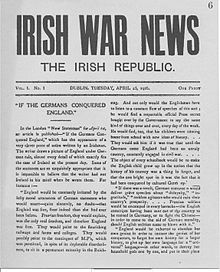
Picture - Irish War News, produced during the Rising
In County Wexford, some 100 Volunteers took over Enniscorthy on Thursday 27 April until the following Sunday. The made a brief and unsuccessful attack on the RIC barracks, but unable to take it, resolved to blockade it instead. During their occupation of the town, they made such gestures as flying the tricolour over the Atheneum theatre, which they had made their headquarters, and parading uniformed in the streets.
A small party set off for Dublin, but turned back when they met a train full of British troops (part of a 1,000-strong force) on their way to Enniscorthy. On Saturday, two Volunteer leaders were escorted by the British to Arbour Hill Prison, where Pearse ordered them to surrender.
Galway
In the west, Liam Mellows led 600-700 Volunteers in abortive attacks on several police stations, at Oranmore and Clarinbridge in County Galway. There was also a skirmish at Carnmore in which two RIC men were killed. However his men were poorly-armed, with only 25 rifles and 300 shotguns, many of them being equipped only with pikes. Towards the end of the week, Mellows' followers were increasingly poorly-fed and heard that large British reinforcements were being sent westwards. In addition, the British warship, HMS Gloucester arrived in Galway Bay and shelled the fields around Athenry where the rebels were based.
On 29 April the Volunteers, judging the situation to be hopeless, dispersed from the town of Athenry. Many of these Volunteers were arrested in the period following the rising, while others, including Mellows had to go "on the run" to escape. By the time British reinforcements arrived in the west, the rising there had already disintegrated.
Casualties
The British Army reported casualties of 116 dead, 368 wounded and 9 missing. Sixteen policemen died, and 29 were wounded. Rebel and civilian casualties were 318 dead and 2,217 wounded. The Volunteers and ICA recorded 64 killed in action, but otherwise Irish casualties were not divided into rebels and civilians. All 16 police fatalities and 22 of the British soldiers killed were Irishmen
The majority of the casualties, both killed and wounded, were civilians. Both sides, British and rebel, shot civilians deliberately on occasion when they refused to obey orders such as to stop at checkpoints. On top of that, there were two instances of British troops killing civilians out of revenge or frustration, at Portobello Barracks, where six were shot and North King Street, where 15 were killed.
However the majority of civilian casualties were killed by indirect fire from artillery, heavy machine guns and incendiary shells. The British, who used such weapons extensively, therefore seem to have caused most non-combatant deaths. One Royal Irish Regiment officer recalled, "they [British troops] regarded everyone as an enemy and fired at everything that moved".
Aftermath
Picture - Sackville Street (now O'Connell Street), Dublin, after the Rising
Arrests and executions
General Maxwell quickly signalled his intention âto arrest all dangerous Sinn Feiners,â including âthose who have taken an active part in the movement although not in the present rebellion,â reflecting the popular belief that Sinn Féin, a separatist organisation that was neither militant nor republican, was behind the Rising.
A total of 3,430 men and 79 women were arrested, although most were subsequently released. In attempting to arrest members of the Kent family in County Cork on 2 May, a Head Constable was shot dead in a gun battle. Richard Kent was also killed, and Thomas and William Kent were arrested.
In a series of courts martial beginning on 2 May, ninety people were sentenced to death. Fifteen of those (including all seven signatories of the Proclamation) had their sentences confirmed by Maxwell and were executed by firing squad between 3 May and 12 May (among them the seriously-wounded Connolly, shot while tied to a chair due to a shattered ankle). Not all of those executed were leaders: Willie Pearse described himself as "a personal attaché to my brother, Patrick Pearse"; John MacBride had not even been aware of the Rising until it began, but had fought against the British in the Boer War fifteen years before; Thomas Kent did not come out at all-he was executed for the killing of a police officer during the raid on his house the week after the Rising. The most prominent leader to escape execution was Eamon de Valera, Commandant of the 3rd Battalion. The president of the courts-martial was Charles Blackader.
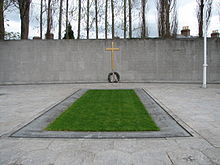
Picture - The burial spot of the Leaders of the Rising, in the old prison yard of Arbour Hill prison. The memorial was designed by G. McNicholl. The Proclamation of 1916 is inscribed on the wall in both Irish and English
1,480 men were interned in England and Wales under Regulation 14B of the Defence of the Realm Act 1914, many of whom, like Arthur Griffith, had little or nothing to do with the affair. Camps such as Frongoch internment camp became âUniversities of Revolutionâ where future leaders like Michael Collins, Terence McSwiney and J. J. O'Connell began to plan the coming struggle for independence. Sir Roger Casement was tried in London for high treason and hanged at Pentonville Prison on 3 August.
03 May: Patrick Pearse, Thomas MacDonagh and Thomas J. Clarke
04 May: Joseph Plunkett, William Pearse, Edward Daly and Micheal O'Hanrahan
05 May: John MacBride
08 May: Eamonn Ceannt, Micheal Mallin, J.J. Heuston and Cornelius Colbert
12 May: James Connolly and Sean MacDiarmada
Inquiry
A Royal Commission was set up to enquire into the causes of the Rising. It began hearings on 18 May under the chairmanship of Lord Hardinge of Penshurst. The Commission heard evidence from Sir Matthew Nathan, Augustine Birrell, Lord Wimborne, Sir Neville Chamberlain (Inspector-General of the Royal Irish Constabulary), General Lovick Friend, Major Ivor Price of Military Intelligence and others. The report, published on 26 June, was critical of the Dublin administration, saying that "Ireland for several years had been administered on the principle that it was safer and more expedient to leave the law in abeyance if collision with any faction of the Irish people could thereby be avoided." Birrell and Nathan had resigned immediately after the Rising. Wimborne had also reluctantly resigned, but was re-appointed, and Chamberlain resigned soon after.
Reaction of the Dublin public
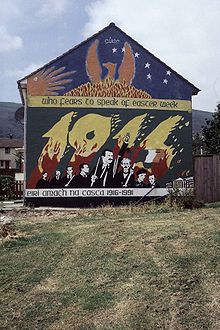
Picture - A mural in Belfast commemorating the rising
At first, many members of the Dublin public were simply bewildered by the outbreak of the Rising. James Stephens, who was in Dublin during the week, thought, "None of these people were prepared for Insurrection. The thing had been sprung on them so suddenly they were unable to take sides".
There was considerable hostility towards the Volunteers in some parts of the city. When occupying positions in the South Dublin Union and Jacobs factory, the rebels got involved in physical confrontations with civilians trying to prevent them from taking over the buildings. The Volunteers' shooting and clubbing of civilians made them extremely unpopular in these localities. There was outright hostility to the Volunteers from the "separation women", (so-called because they were paid "Separation Money" by the British government) who had husbands and son fighting in the British Army in World War I, and among unionists. Supporters of the Irish Parliamentary Party also felt the rebellion was a betrayal of their party.
Finally, the fact that the Rising had caused a great deal of death and destruction also contributed towards antagonism towards the rebels. After the surrender, the Volunteers were hissed at, pelted with refuse, and denounced as 'murderers' and 'starvers of the people'. Volunteer Robert Holland for example remembered being abused by people he knew as he was being marched into captivity and said the British troops saved them from being manhandled by the crowds.
However, there was not universal hostility towards the defeated insurgents. Some onlookers were cowed rather than hostile and it appeared to the Volunteers that some of those watching in silence were sympathetic. Canadian journalist and writer Frederick Arthur McKenzie wrote that in poorer areas, "there was a vast amount of sympathy with the rebels, particularly after the rebels were defeated." Thomas Johnson, the Labour leader thought there was, "no sign of sympathy for the rebels, but general admiration for their courage and strategy"
The aftermath of the Rising, and in particular the British reaction to it, helped to sway a large section of Irish nationalist opinion away from hostility or ambivalence and towards support for the rebels of Easter 1916. Dublin businessman and Quaker James Douglas, for example, hitherto a Home Ruler, wrote that his political outlook changed radically during the course of the Rising due to the British military occupation of the city and that he became convinced that parliamentary methods would not be sufficient to remove the British presence.
Rise of Sinn Féin
A meeting called by Count Plunkett on 19 April 1917 led to the formation of a broad political movement under the banner of Sinn Féin which was formalised at the Sinn Féin Ard Fheis of 25 October 1917. The Conscription Crisis of 1918 further intensified public support for Sinn Féin before the general elections to the British Parliament on 14 December 1918, which resulted in a landslide victory for Sinn Féin, whose MPs gathered in Dublin on 21 January 1919 to form Dx¡il xireann and adopt the Declaration of Independence.
Legacy
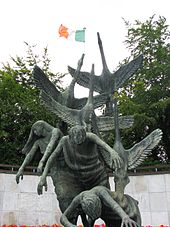
Picture - The Garden of Remembrance was opened in 1966, to mark the anniversary of the Rising. The Garden is "dedicated to all those who gave their lives in the fight for Ireland's freedom"
A few months after the Easter Rising, W. B. Yeats expressed his torn emotions regarding these events in the poem Easter, 1916. Some survivors of the Rising went on to become leaders of the independent Irish state and those who died were venerated by many as martyrs. Their graves in the former military prison of Arbour Hill in Dublin became a national monument and the text of the Proclamation was taught in schools. An annual commemoration, in the form of a military parade, was held each year on Easter Sunday, culminating in a huge national celebration on the 50th anniversary in 1966. RTE the Irish national broadcaster, as one of its first major undertakings made a series of commemorative programmes for the 1966 anniversary of the Rising. Roibéx¡rd x Farachx¡in, head of programming said, âWhile still seeking historical truth, the emphasis will be on homage, on salutationâ
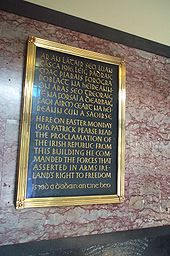
Picture - A plaque commemorating the Easter Rising at the General Post Office, Dublin, with the Irish text in Gaelic script, and the English text in regular Latin script
With the outbreak of the Troubles in Northern Ireland, government, academics and the media began to revise the countryâs militant past, and particularly the Easter Rising. The coalition government of 1973-77, in particular the Minister for Posts and Telegraphs, Conor Cruise O'Brien, began to promote the view that the violence of 1916 was essentially no different from the violence then taking place in the streets of Belfast and Derry.
Cruise O'Brien and others asserted that the Rising was doomed to military defeat from the outset, and that it failed to account for the determination of Ulster Unionists to remain in the United Kingdom. "Revisionist" historians began to write of it in terms of a "blood sacrifice".
While the Rising and its leaders continued to be venerated by Irish republicans - including members and supporters of the Provisional IRA and the modern Sinn Féin - with murals in republican areas of Belfast and other towns celebrating the actions of Pearse and his comrades, and a number of parades held annually in remembrance of the Rising, the Irish government discontinued its annual parade in Dublin in the early 1970s, and in 1976 it took the unprecedented step of proscribing (under the Offences against the State Act) a 1916 commemoration ceremony at the GPO organised by Sinn Féin and the Republican commemoration Committee.
A Labour Party TD, David Thornley, embarrassed the government (of which Labour was a member) by appearing on the platform at the ceremony, along with Mx¡ire Comerford, a survivor of the Rising, and Fiona Plunkett, sister of Joseph Plunkett.
With the advent of a Provisional IRA ceasefire and the beginning of what became known as the Peace Process during the 1990s, the official view of the Rising became more positive and in 1996 an eightieth anniversary commemoration at the Garden of Remembrance in Dublin was attended by the Taoiseach and leader of Fine Gael, John Bruton. In 2005 the Taoiseach, Bertie Ahern, announced the governmentâs intention to resume the military parade past the GPO from Easter 2006, and to form a committee to plan centenary celebrations in 2016. The 90th anniversary was celebrated with military parade in Dublin on Easter Sunday, 2006, attended by the President of Ireland, the Taoiseach and the Lord Mayor of Dublin.
Easter, 1916
Foggy Dew
Rebel Heart (film)
Rebel Heart (song)
Bibliography
Bell, J. Bowyer, The Secret Army: The IRA ISBN 1-85371-813-0
Caulfield, Max, The Easter Rebellion, Dublin 1916 ISBN 1-57098-042-X
Coogan, Tim Pat, 1916: The Easter Rising ISBN 0-304-35902-5
Coogan, Tim Pat, The IRA (Fully Revised & Updated), HarperCollins, London, 2000, ISBN 0-00-653155-5
De Rosa, Peter. Rebels: The Irish Rising of 1916. Fawcett Columbine, New York. 1990. ISBN 0-449-90682-5
Foy, Michael and Barton, Brian, The Easter Rising ISBN 0-7509-2616-3
Greaves, C. Desmond, The Life and Times of James Connolly
Kee, Robert, The Green Flag ISBN 0-14-029165-2
Kostick, Conor & Collins, Lorcan, The Easter Rising, A Guide to Dublin in 1916 ISBN 0-86278-638-X
Lyons, F.S.L., Ireland Since the Famine ISBN 0-00-633200-5
Martin, F.X. (ed.), Leaders and Men of the Easter Rising, Dublin 1916
Macardle, Dorothy, The Irish Republic
McNally, Michael and Dennis, Peter, Easter Rising 1916: Birth of the Irish Republic (2007), Osprey Publishing, ISBN 9781846030673
Murphy, John A., Ireland In the Twentieth Century
Neeson, Eoin, Myths from Easter 1916, Aubane Historical Society, Cork, 2007, ISBN 978-1-903497-34-0
x Broin, Leon, Dublin Castle & the 1916 Rising, Sidgwick & Jackson, 1970
Purdon, Edward, The 1916 Rising
Townshend, Charles, Easter 1916: The Irish Rebellion
The Memoirs of John M. Regan, a Catholic Officer in the RIC and RUC, 1909-48, Joost Augusteijn, editor, Witnessed Rising, ISBN 978-1-84682-069-4.
Clayton, Xander: AUD, Plymouth 2007.
Eberspx¤cher, Cord/Wiechmann, Gerhard: "Erfolg Revolution kann Krieg entscheiden". Der Einsatz von S.M.H. LIBAU im irischen Osteraufstand 1916 ("Success revolution may decide war". The use of S.M.H. LIBAU in the Irish Easter rising 1916), in: Schiff & Zeit, Nr. 67, Frx¼hjahr 2008, S. 2-16.
Edited by Rux¡n OâDonnell, The Impact of the 1916 Rising: Among the Nations, Irish Academic Press Dublin 2008, ISBN 978 0 7165 2965
More aircraft.
Source: WikiPedia